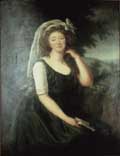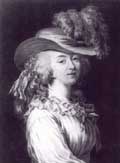 |
 |
 |
 |
 |
 |
 |
 |
| 1781 | 1781 | 1787 | 1787 | 1789-1820 | 1820 | 1782 |
|---|
 |
 |
 |
 |
 |
 |
 |
 |
| 1781 | 1781 | 1787 | 1787 | 1789-1820 | 1820 | 1782 |
|---|
|
|
| Mercè Alabern of Barcelona, Spain is in the
process of writing a book on the life of Mme. du Barry and has provided a
short biography of Mme. du Barry's
life. The biography is also provided in En
Español andItalian .
According to her memoirs Vigée Le Brun painted three portraits of her: 1781 Countess du Barry (w/straw hat), 1782 Mme.du Barry (full length w/wreath in hand), 1789 Mme.du Barry. The fourth painting was completed in 1820. The fifth painting shown here is a copy (of the fourth painting) by Eugénie Tripier Lefranc, Vigee Le Brun's niece. It was completed at the same time Vigée Le Brun completed the original in 1820.
|
 |
Madame Du Barry - 1781 Oil on panel 27.25 x 20.25 in (69.2 x 51.4 cm) This is believed to be a copy by Vigee Le Brun of the painting below. The painting was gifted to the Philadelphia Art Museum in 1984 by the previous owner Mrs Fleming. View a larger version of this painting image. This painting can also be found on Art Page 138
|
 |
Madame Du Barry - 1781 oil on canvas Rothchild collection. This is believed to be the first painting Vigée Le Brun painted of Mme du Barry. According to her memoirs Vigée Le Brun painted three portraits of her: 1781 Countess du Barry (w/straw hat), 1782 Mme du Barry (full length w/wreath in hand), 1789 Mme du Barry. This image can also be found on Art Page 43
|
 |
Madame Du Barry - 1787 Oil on panel This is believed to be a 1787 copy by Vigee Le Brun of the countess du Barry painted in 1781. View the original on Art Page 43 and another copy at Art Page 138
|
 |
Mme du Barry-1787 oil on canvas This is the second painting Vigée Le Brun painted of Mme du Barry. This image can also be found on Art Page 68
|
 |
Mme du Barry-1789-1820 oil on canvas Mme du Barry is 46 years old in this portrait. "The third portrait I made of Mme Du barry [was begun] towards the middle of September 1789....I had painted the head and traced the outline of the body and arm....My fear reached a peak and my only thought was to leave France, so I had to abandon the painting half finished. I do not know by what stroke of good fortune M.le Comte Louis de Narbonne found himself in possession of it during my absence; on my return to France, he gave it to me and I have only just completed it" Vigee Le Brun. The painting was finished around 1820. This image can also be found on Art Page 38 |
 |
Mme du Barry - 1820 oil on canvas, Musée Lambinet, Versailles Copy of original by Eugénie Tripier Lefranc, Vigee Le Brun's niece. The painting was made at the same time Vigée Lebrun made the original so this copy by Tripier Lefranc was finished arround 1820. Eugénie Tripier Lefranc was born in Paris in 1803 or 1805 and died in Paris in 1872.
|
 |
Mme Dubarry - 1782 This is a copy of Vigee-Lebrun's Mme Dubarry portrait by pupil Mm. Lemoine. It is in aprivate collection at Louveciennes. Notice that the brush strokes are more loosely rendered and the head is a different shape. |
|
Vigée Le Brun's Home Page | Special Galleries |